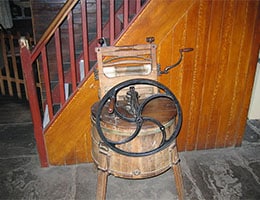 Lavarropas is a term that can be used in the feminine ( the launderette ) or in the masculine ( the launderette ). This is the name of the machine used to wash clothes .
Lavarropas is a term that can be used in the feminine ( the launderette ) or in the masculine ( the launderette ). This is the name of the machine used to wash clothes .
Mentioned in the singular as washing machine or washing machine , the concept is frequently used in Argentine territory and in Uruguay , although in other countries the notion of washing machine is preferred. Washing machine and washing machine, therefore, are synonyms: they refer to the same thing.
A washing machine, in short, is an electromechanical device that has a drum where dirty clothes are deposited. Said drum, in turn, has holes that allow water to enter.
In this way, the washing machine must be connected to the electrical network and also to the water supply network. The user has to add soap or detergent to the indicated place, turn on the machine and open the tap (tap). Thus, thanks to an electric motor, the washing machine drum rotates while it fills with water, which mixes with the soap. In general, the standard process includes several washes and rinses and a spin so that the clothes are as dry as possible.
The most modern washing machines have sensors that allow you to control the speed of rotation of the drum and the temperature of the water, among other variables. They also indicate the time it takes to wash.
At a general level, there are two main types of washing machines: opening or top loading and opening or front loading . In the case of top-opening washing machines, the door that provides access to the drum is at the top, while in front-opening washing machines, it is in the front section.
The history of the washing machine dates back to the end of the 17th century, more precisely to the year 1690, when the first patent was registered in England, which was included in the category of washing and draining machines . Needless to say, this first prototype did not operate with electricity, but rather completely manually and mechanically.
 Almost a century later, in 1767, the German inventor Jacob Christian Schäffer published his own design, and more and more appeared, each with certain characteristics that offered greater comfort or better performance. In 1782, for example, the Englishman Henry Sidgier obtained a patent for a model with a rotating drum, and in 1862 the first compact rotating washing machine appeared at the World's Fair in London .
Almost a century later, in 1767, the German inventor Jacob Christian Schäffer published his own design, and more and more appeared, each with certain characteristics that offered greater comfort or better performance. In 1782, for example, the Englishman Henry Sidgier obtained a patent for a model with a rotating drum, and in 1862 the first compact rotating washing machine appeared at the World's Fair in London .
An unfortunate anecdote related to the history of the washing machine took place in the United States between the end of the 18th century and the beginning of the 19th century, when a fire in the Patent Office destroyed all traces of the patent that the inventor Nathaniel Briggs had obtained in 1797. If there were As a matter of record, today he could be officially declared the first American to have patented a washing machine.
One of the most interesting inventions for users at that time were the "wringing rollers ", which allowed the clothes to be passed between them as if it were fresh pasta dough with the aim of removing all the water it had absorbed and leaving it ready. to hang outdoors. This was much better than wringing it by hand since it prevented wrinkles and, needless to say, reduced physical effort.
At the beginning of the 20th century, the first electric washing machines appeared in North America and by 1930 they had reached a significant level of popularity. In 1940 alone it is estimated that there were one in six out of every ten homes with access to electricity. It didn't take long until it became an item of mass use worldwide, and thus the big brands that today dominate the washing machine market emerged.
